- 5 unforgettable BBQ marinades
- How to Make a Perfect Roast Every Time
- Filet mignon: different recipes for different cuts
- Guide to Cooking Beef
- Tips on How to BBQ Like a Pro
- 5 Ways To Reinvent the Burger
- Prepare and Cook Sausages
- Skewers Bar: Pile Up on Flavour
- 6 Pork Cuts You’re Sure to Love
- Spices to Flavour Meat
- Soul Food at Home
All About Lamb

Lamb aficionados simply rave about this tender, juicy, flavourful meat. It’s one of the most popular foods in the world, as evidenced by the fact that many countries have at least one national dish with lamb.
Though lamb has always been part of grand feasts and special celebrations, it now also has its place in simpler fare. Try ground lamb in everyday dishes such as shepherd's pie or hamburgers, or use it in sausages, a treat when served with couscous. It goes well with mustard, basil, mint, rosemary and sage, and even lemon, lime or orange zest. Add spices such as cumin, cinnamon, ginger, coriander and cloves to lamb dishes, and garlic when roasting leg of lamb.
Types of lamb
Milk-fed baby lamb or suckling lamb
This lamb is generally raised to the age of two months and feeds strictly on its mother’s milk. Because it is very lean, its thin flesh is quite delicate and tender, and its flavour is more subtle than that of meat from older animals. It generally weighs between 10 and 13 kilos.
Light lamb
This is a weaned lamb that is raised on a diet of grain and feed. It is slaughtered when it reaches between two to four months of age. It usually weighs between 13 and 18 kilos.
Heavy lamb
This is a grain-fed lamb aged between three to eight months. Its tender flesh is pinker than that of a milk-fed lamb, and it generally weighs around 22 kilos.
Salty-meadow lamb
This particular lamb is a specialty raised in Île Verte near Rivière-du-Loup, Quebec. It is more muscular but leaner than lamb raised in a sheepfold because it spends four hours a day for a period of 60 days grazing in salty low-tide grasses. It then spends ten days in a sheepfold before it must, by law, be slaughtered locally. This lamb has acquired an international reputation, but its small-scale production does not permit large-scale commercialization.
Similarly, lamb from Quebec’s Kamouraska valley can be considered a salty-meadow lamb because it too grazes in areas salted by seawater spray.
Spring lamb
New Zealand spring lamb is typically slaughtered at five months. It is raised year-round in pastures, not in sheepfolds, and is not given growth hormones, as this is against the law in New Zealand. Spring lamb is available fresh (Cry-O-Vac chilled and packaged) and frozen (vacuum-packed).
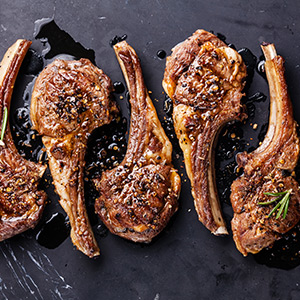
Cooking methods
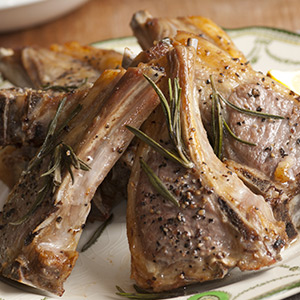
Grilled lamb
- Grilled lamb is cooked at high heat in the oven, on the stovetop or on the barbecue.
- Grilling allows the heat to penetrate the lamb, forcing its fat to caramelize while protecting the flavourful juices within to keep the meat moist.
- Chops, cubes for kebabs or leg of lamb are particularly well suited to this method.
Grilled lamb chops
- All types of lamb chops are excellent grilled, and are especially flavourful if you have the time to marinate them.
- Remove any visible fat, especially the strip along the edge.
- Score the remaining fat at the edges of the chop to prevent it from curling up during cooking.
- Marinate for a minimum of 3 hours (this is optional, but will heighten the flavour).
- Grill in a very hot oven, on the barbecue, or in a non-stick pan on the stovetop with a small amount of cooking oil for 4 minutes on each side. (Do not use oil if you’ve already brushed the meat with a marinade)
- Turn the chops once only, using tongs to avoid piercing the meat.
- To give the fat on the side of the chops a golden colour, rest the fat briefly against the heat just before serving.
- Serve on warmed plates.
Grilled lamb kebabs
- Lamb is particularly good on skewers, where it can cook rapidly and retain all its tenderness. To prepare kebabs, have the leg, shoulder or lamb fillet cut into 3 cm (1½ in) cubes or better yet, simply buy the lamb skewers ready-made at your METRO butcher’s counter.
- Place the cubes in the marinade of your choice.
- Thread the cubes onto skewers, leaving a small space between each piece to ensure uniform cooking.
- Place under the oven broiler or on the barbecue grill and cook for 6 to 8 minutes, turning frequently.
- Serve on warmed plates.

Grilled leg of lamb
- This classic dish can be marinated in yogurt, lemon juice and olive oil for Greek-inspired flavours, or coated with thyme or rosemary for a Provençal touch.
- Rub the leg of lamb with a mixture of olive oil and spices and place on the grill.
- Cook for 20 to 30 minutes. The meat should be caramelized but still tender.
- Remove from heat and place the lamb on a cutting board. Cover loosely with aluminum foil, allowing steam to escape. Let the meat rest for about 15 minutes. This allows the juices to permeate the meat, increasing tenderness and flavour, and ensuring even cooking.
- Serve on warmed plates.
Roasted lamb
- The leg, shoulder, and rack of lamb ribs are the best pieces for roasting. A meat thermometer is particularly helpful when roasting lamb.
- When roasting lamb, use a pan that has a rack or a perforated pan that the lamb can be placed on, so the meat does not cook in its own fat.
- Generally, lamb should be cooked at 180°C (350°F) for 12 minutes per 500 grams.
- To properly roast a lamb shoulder on the spit, coat the meat entirely with Dijon mustard diluted in a little white wine.
- For herbed leg of lamb, tie sprigs of thyme, rosemary or other herbs around the meat.
- Once cooked, wrap the meat loosely in aluminum foil to allow steam to escape. Let rest for 15 minutes. This allows the juices to fully penetrate the meat, maximizing flavour and ensuring tenderness.
- Always serve lamb on warmed plates.
Rack of lamb
- Rack of lamb is so good and so simple to prepare. If you haven’t tried it yet, wait no longer—your dinner guests will be very impressed!
- Rub the rack of lamb with Dijon mustard.
- Sprinkle a mixture of finely chopped fresh herbs and breadcrumbs over the mustard coating.
- Place the lamb in a roasting pan and cook at 180°C (350°F) until it reaches the desired degree of doneness.
- Serve on warmed plates.
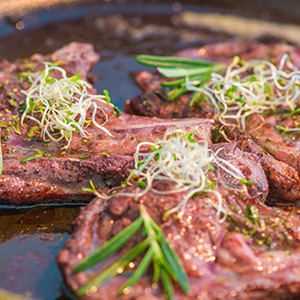
Stuffed leg of lamb
- With this recipe, you add the thousand and one aromas of stuffing to the delicate natural scent of lamb.
- Place the stuffing of your choice in the cavity of the boned leg of lamb. Remember that the stuffing will swell during cooking, so don’t pack it too tightly.
- Truss the leg and place in a roasting pan. Sear on all sides in a mixture of hot oil and butter.
- Transfer roasting pan into a 180°C (350°F) oven.
- Mid-way through the cooking process, insert a meat thermometer in the thickest part of the leg and continue cooking until the temperature indicates the lamb is ready.
Braised lamb
- The taste of braised lamb can be enhanced by stuffing or coating the meat. This will keep the lamb moist and tender by sealing the juices inside the meat.
- Blanch vegetables such as carrots, potatoes or turnips for 10 minutes.
- In a large casserole, brown meat (shoulder or neck) on all sides.
- Add a cold liquid such as water, beef or chicken broth, the vegetables and the herbs and spices of your choice.
- Cover and cook at low heat.
Stuffed shoulder of lamb
- Cut the meat open, lay flat on the cutting board and spread stuffing almost to the edges of the meat.
- Roll the meat so that it is compact and will be easy to cut. Truss it with string.
- Sear it lightly in a mixture of oil and butter to give it a golden colour.
- Add pearl onions.
- Add the broth of your choice, cover and cook for 1½ to 2 hours in a 180ºC (350ºF) oven.
- Add any other vegetables 30 minutes before cooking is complete.
Tips and advice
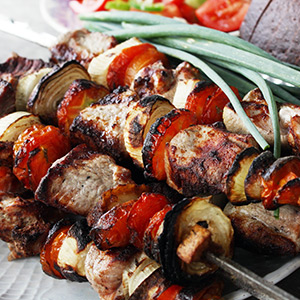
- Avoid lamb that is very dark and viscous. Your selection, when cut, should show a fine grain and should not have a strong odour. The fatty border should be firm, white and slightly waxy in appearance, and should form an even layer. Never buy a piece of lamb surrounded by a layer of yellow fat.
- Plan on 150 grams per serving of lamb kebabs, leg or rump; 200 grams of brochette or stewing cubes; and 375 grams of lamb chops.
- Your METRO butcher carries a wide selection of lamb cuts, from rack and leg of lamb to shoulder, tenderloin, roasts, stewing and kebab cubes, saddle of lamb and ground lamb.
- If you cannot find fresh lamb, don’t hesitate to purchase it frozen. Lamb freezes well, and its flavour is not affected by the process.
- Never cook a cut of lamb that is partially frozen. Always thaw it completely to ensure uniform cooking.
- It’s best to carefully remove any visible fat before cooking (it should separate easily from the meat) and to degrease the cooking juices. Lamb’s natural fat will keep it moist as it cooks.
- Lamb that has been marinated for at least one hour will be more tender and flavourful. For the best results, leave it to marinate overnight, but no longer than 24 hours, or the marinade will start to cook the meat.
- Baste lamb regularly during cooking to keep it moist, and avoid piercing the meat to preserve all its tender juices.
- Once cooked, remove lamb from pan and wrap loosely in aluminum foil, allowing the vapour to escape. Let stand for 5 to 10 minutes. The fibres will relax and the juices will circulate back into the meat.
- Like all fatty meats, lamb should be served at its warmest. It’s a good idea to always warm your dishes before serving because lamb cools very quickly and the fat will congeal.
- Lamb is delicious finished with a flavoured butter. To make the butter, simply blend softened butter with your choice of fresh tarragon, watercress, garlic or other herbs and spices.
Expert Tip
Many traditional lamb dishes use dried fruits, such as raisins, apricots and prunes. You can also try adding fresh fruit to lamb dishes, such as apple and figs, for a sweet counterpoint to the rich meat.
How to know when cooked lamb is done
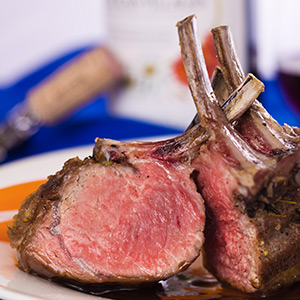
- Cooking time for lamb can be tailored to individual preferences. Generally, novices prefer it served slightly pink, while aficionados prefer it rare.
- Cooking time will vary depending upon the cut of lamb being used, so a meat thermometer can help ensure you get the desired degree of doneness. Here are the internal temperatures to watch for.
- For Rare meat. Cook to 63˚C (145˚F)
- For Medium pink meat. Cook to 65˚C (149˚F)
- For Well-done meat. Cook to 77˚C (170˚F)
Nutritional value
Lamb is rich in protein, zinc, and vitamin B complex (niacin, riboflavin, and B12). It is also a good source of iron; not as much as beef, but more so than veal. It also contains potassium and phosphorus.
Of all the butcher shop meats available, lamb is highest in saturated fat. Much of the fat on lamb, however, is easily removed, and the leg, rack and loin are much leaner than the shoulder.
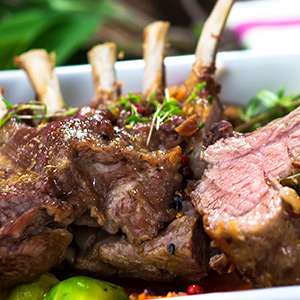
Storage
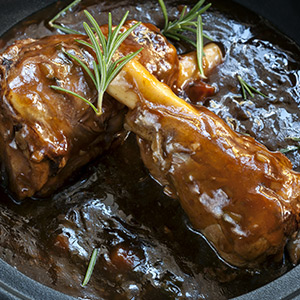
- Store lamb in the coldest part of the refrigerator, between 0°C (32°F) and 4°C (40°F), in its original wrapper if intact, away from any cooked meats.
- Cuts of lamb, such as a roast or chops, can be refrigerated for up to three days if wrapped in plastic and then in aluminum foil.
- Wrapped in plastic and then foil, ground lamb or fresh sausage can be kept in the refrigerator for up to three days, and in the freezer for two to three months.
- If the lamb is cooked, ensure that it is at room temperature before wrapping in aluminum foil and placing in the refrigerator. When wrapped this way, lamb can be refrigerated for three to four days.
- Wrapped in plastic and then in aluminum foil, lamb can be frozen for six to nine months. You can also use air-tight freezer bags or freezer-safe containers.
- Lamb should be thawed slowly. Leave the meat in its wrapping, put it on a plate and place in the coldest part of the refrigerator. It will take 8 to 12 hours per kilo (4 to 6 hours per pound). To thaw lamb quickly, place it in cold water.
- Thawed meat should be used within two days.
Try these delicious recipes















